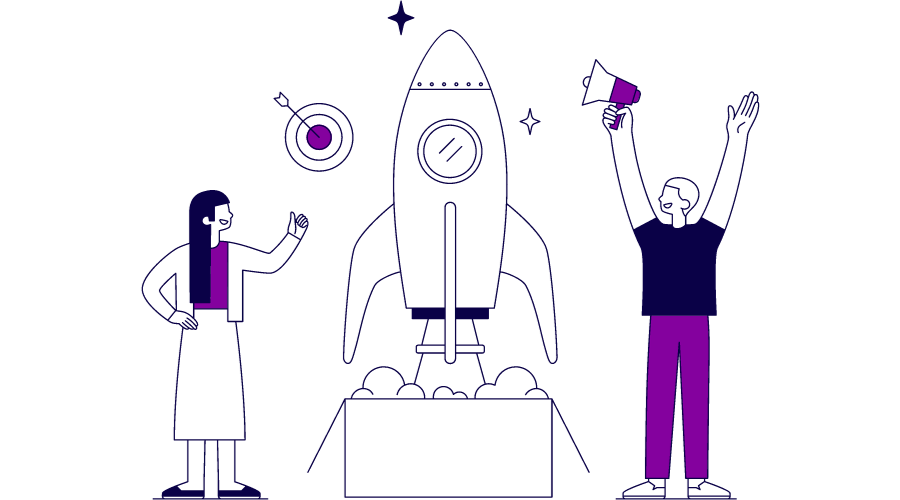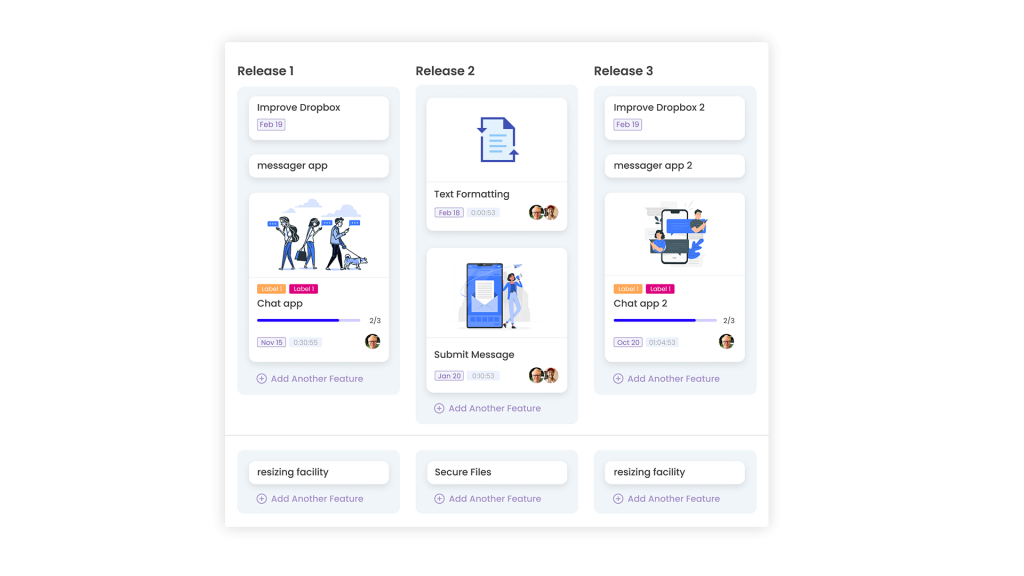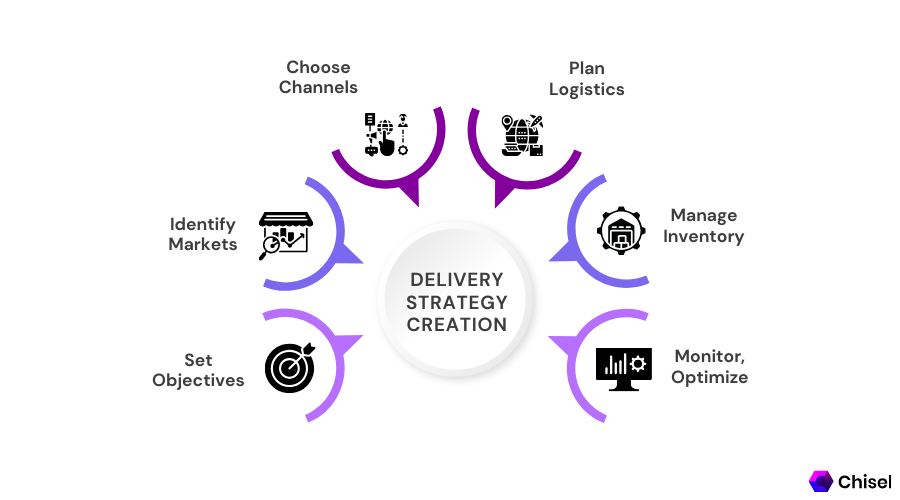Product Delivery: The Ultimate Guide

Delivering a product to your end-user can be quite a daunting task. There are so many things that go into it – from ideation to development to release and post-release.
This article will look at the entire product delivery process and everything that goes into it. We will also explore agile product delivery and how it can help make the process smoother.
As a product manager, it is essential to understand every aspect of product delivery to create successful products for your company!
It is also equally important to use a good product management tool that helps you craft amazing products and keep track of the product life cycle. Chisel is a primary that product managers rely on, and you must experience it too!
Sign up today and create product roadmaps, build team alignment and collect customer feedback.
Let’s begin!
What is Product Delivery?
Product delivery is taking a product or feature from ideation to release. This involves multiple steps, including development, testing, and deployment.

The goal of product delivery is to create a successful product that meets the needs of your end-user. It is essential to have a clear understanding of your product, your user, and the market.
It is also essential to have a solid team to help you execute your vision.
The product delivery process will vary depending on the company, the product, and the team. However, some standard steps are typically involved:
- Ideation: This is the first step in the product delivery process. During this phase, you will develop your product idea and flesh it out.
- Development: Once you have a solid idea, it’s time to develop your product. This includes designing, coding, and testing your product.
- Release: Once your product is ready, it is time to release it. This can be a daunting process, but you can make it happen with the proper planning and execution.

Chisel’s release view organizes features into release sprints to keep your deliverables on track.
- Post-Release: After your product is released, it’s essential to continue monitoring and optimizing it. This includes tracking usage data, fixing bugs, and making changes based on feedback from your users.
Wait, let’s not get into the details of the process just yet. It is essential first to understand the people behind the product delivery process.
“People are the heart of your business.” – Julia Felton (Chief Experience Officer at Business HorsePower)
Product Delivery Manager
A product delivery manager heads the product delivery process.
The role of a product delivery manager is critical to the success of a product delivery process.
Role of a product delivery manager
The product delivery manager ensures that the product delivery process goes smoothly.
They are responsible for managing the project schedule, budget, and resources.
The product delivery manager also ensures that you keep all stakeholders up to date on any potential delays or issues.
Key Responsibilities of a Product Delivery Manager
A product delivery manager is responsible for successfully delivering a product to its end-users. They work with different teams to ensure that the product is delivered on time and within budget.
The key responsibilities of a product delivery manager are:
- Planning and Execution: A product delivery manager needs vital planning and execution skills. They need to be able to plan the delivery process and then execute it flawlessly.
- Coordination: A product delivery manager needs to be able to coordinate with different teams across the company. They need to work with the engineering team, QA team, product marketing team, and more.
- Communication: A product delivery manager needs to have strong communication skills. They need to communicate the delivery process and timeline to different teams and stakeholders.
- Project Management: A product delivery manager needs strong project management skills. They need to be able to manage the delivery process from start to finish.
- Problem-Solving: A product delivery manager needs to have strong problem-solving skills. They need to identify and solve problems that arise during the delivery process.
The ship is as strong as its sailor. The expertise of the product delivery manager plays a vital role in your product delivery success.
Now, the manager is no lone wolf. They come with a pack- the product delivery team.
Product Delivery Team
The product delivery team is responsible for the successful delivery of a product to its end-users. The group consists of members from different departments across the company.
Departments of a Product Delivery Team
The product delivery team is essential because it brings together different departments across the company to work on a product.
The team typically includes members from the following departments:
- Engineering: The engineering team is responsible for building the product. They work with the product delivery manager to ensure that the product is delivered on time and within budget.
- UX/UI: The UX/UI team is responsible for designing the user interface and experience. They ensure the user’s product experience is as pleasant and smooth as possible. Be it a simple login page or a test drive.
- QA: The QA team is responsible for testing the product. They work with the engineering team to ensure that the product is of high quality and meets the requirements set by the product delivery manager.
- Product Marketing: The product marketing team is responsible for promoting the product. They work with the engineering team to create a launch plan and promote the product post-launch.
- Sales: The sales team is responsible for selling the product. They work with the product marketing team to promote the product and generate sales.
- Customer Success: The customer success team is responsible for ensuring that the customers are successful with the product. They work with the sales team to onboard and train customers on how to use the product.
Now that we know the brains and hands behind the process, how about we get into the actual process?
The product delivery process can be pretty complex, but you can create a masterpiece for your company with the correct planning and execution.
Product Delivery Methods
There are multiple ways to deliver a product. The most common methods are as follows-
- Lean Startup Method
- Waterfall Method
- Agile Method
Let’s understand each of these product delivery methods in detail and pick the one that best fits your needs.
Lean Startup Method
The Lean Startup Method is a popular product delivery method that focuses on creating and releasing products quickly. Startups often use this method as it helps them to validate their product ideas rapidly.
Eric Ries first introduced the lean startup product delivery method in his book, The Lean Startup.
Key Principles
- Validate your product idea: This is the first step in the lean startup process. You need to validate your product idea by testing it with potential customers.
- Build a Minimum Viable Product (MVP): Once you have validated your product idea, it’s time to build your MVP. An MVP is a stripped-down version of your product that includes only the essential features. This will help you test and validate your product idea with real users.
- Release quickly and iterate: The key to the lean startup method is releasing your product quickly and then iterating based on feedback. This helps you save time and money while still getting your product out there.
The main goal of the Lean Startup Method is to release a minimum viable product (MVP) as soon as possible. This MVP can then gather feedback from your users and determine if the product is viable.
One of the advantages of using this product delivery method is that it helps you avoid wasting time and money on a product that may not be successful.
Waterfall Method
The Waterfall Method is a traditional product delivery method that follows a sequential process. This means that you must complete each stage before moving on to the next step.
This product delivery method can be quite a lengthy and complicated process, but it does have its benefits.
Dr. Winston W. Royce first introduced the waterfall method in 1970, and it has been used extensively since then.
Key Principles
- Planning: The first step in the waterfall method is planning. This includes understanding the requirements of your product and designing a roadmap for delivery.
- Development: Once the planning is complete, development begins. This includes designing and coding the product and performing unit testing.
- Testing: After developing the product, it is time for quality assurance (QA) testing. This involves testing the product against the requirements and fixing any bugs found.
- Release: Once the product is ready, you release it to the end-user.
The main advantage of using the waterfall method is that it provides a sequential process for delivering your product. This helps ensure that each stage is complete before moving on to the next step.
However, one of the disadvantages of this product delivery method is that it can be inflexible. This is because one cannot make changes once development has begun.
That’s where Agile comes in.
Agile Method
The Agile Method is a popular product delivery method that focuses on flexibility and collaboration. This means that it is easier to make changes during the development process.
The Agile Manifesto first introduced this method in 2001 and has been used extensively since then.
The agile method is a popular product delivery method as it helps to save time and money. This is because it is easier to make changes during the development process.
Key Principles
- Iterative and incremental development: The agile method focuses on delivering your product in small increments. This means that you will release your product in stages, with each stage adding new features.
- Collaboration: Another fundamental principle of agile is collaboration. All stakeholders (including the product owner, developers, and testers) work together to deliver the product.
- Customer involvement: The agile method also focuses on customer involvement. This means that customers are involved throughout the development process and provide feedback.
The agile method is a popular product delivery method as it helps to save time and money. This is because it is easier to make changes during the development process.
However, one of the disadvantages of agile is that it can be challenging to manage. This is because there are a lot of stakeholders involved, and the process can be pretty complex.
Agile is a newer approach that involves delivering the product in small, incremental pieces.
This product delivery method can be a more efficient process, but it does require more flexibility from both the team and the product manager.
Which method you choose will depend on your company, team, and product.
Irrespective of the product delivery method you choose, there are bound to be specific product delivery problems you may encounter on the way. It is essential to be aware of these before you begin.
Here’s a heads up!
Product Delivery Problems
Here are some common product delivery problems that product managers and teams face with their products.
Scope creep
This is one of the most common product delivery problems and occurs when the scope of your product delivery changes.
This can happen for several reasons, such as adding new features or changes to the existing product.
It is essential to prevent scope creep by maintaining clear communication with all stakeholders and having a well-defined product delivery plan.
Lack of resources
This is another common product delivery problem and can occur for many reasons, such as budget cuts or unrealistic deadlines.
It can be challenging to meet the deadlines and deliver the product on time when this happens.
It is essential to plan for potential resource shortages and have a backup plan.
You can avoid such product delivery problems by clearly understanding the resources you need and communicating this to all stakeholders.
Testing problems
A third common problem with product delivery is testing problems. This can include not having enough time for testing or not having enough testers.
Testing problems can lead to delays in the product delivery process and can impact the quality of the product.
It is essential to ensure a robust testing plan and allocate enough time for testing.
Delays
Delays can occur for several reasons, such as problems with the product or changes to the requirements.
It is crucial to be prepared for delays by having a backup plan and communicating any potential delays to all stakeholders.
Quality issues
Quality issues can occur due to several factors, such as poor quality control or changes to the product.
It is essential to prevent quality issues by ensuring a clear understanding of the product and testing it thoroughly before delivery.
Now that you are aware of some of the most common product delivery problems, you can take steps to avoid them.
Your product delivery strategy is how you can pan out every detail of your product development and delivery process and prepare against these problems.
Product Delivery Strategy
Huh? We just went over the methods. What’s a product delivery strategy now?
Let’s begin from scratch, shall we?
What is a product delivery strategy?
A product delivery strategy is a plan that outlines how you will deliver your product to the end-user.
It includes all of the steps involved, from ideation to final delivery.
A good product delivery strategy will help ensure that your product is delivered on time and within budget.
Now that we have a clear understanding of a product delivery strategy, let’s look at how to create one.
Creating a Product Delivery Strategy

You need to take a few key steps when creating your product delivery strategy.
The first step is to understand your product. This means having a clear understanding of the features and benefits of your product.
You also need to understand your target market and what they are looking for in a product.
The second step is to create a product delivery plan. This plan should outline all of the steps involved in the process, from ideation to reality.
The third step is to allocate resources. This includes things like budget, time, and people.
The fourth step is to create a schedule. This schedule should include all of the milestones and deadlines for your product delivery.
The fifth step is to test your product. This includes both functional testing and user acceptance testing.
The sixth step is to launch your product. This includes making sure all necessary preparations are in place and conducting a proper launch.
The seventh step is to track your product. This includes tracking key performance indicators (KPIs) and ensuring that you meet your goals.
In Conclusion
Product delivery is the process of delivering a product to the end-user. It includes all of the steps involved, from ideation to final delivery. A good product delivery strategy will help ensure that your product is delivered on time and within budget.
If you want to learn more about product management, check out our blog for more great articles.
